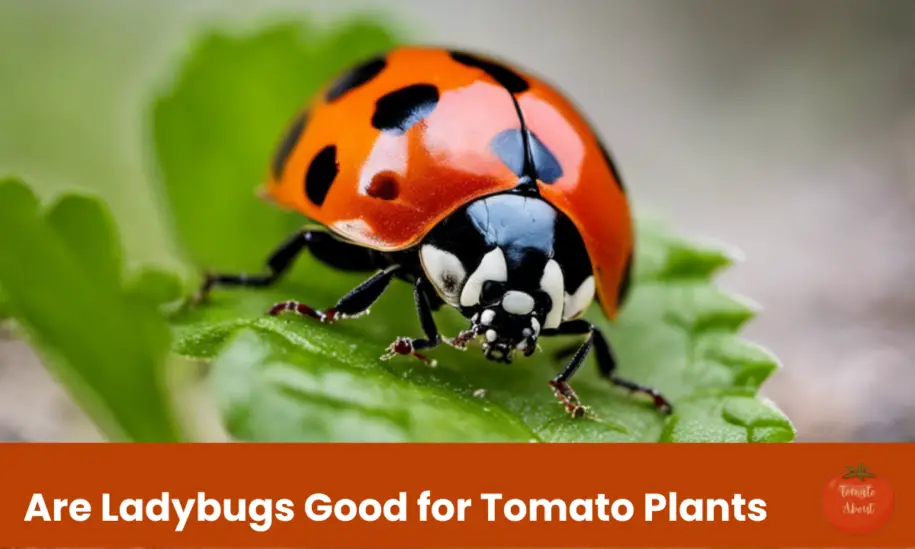Ladybugs, also known as lady beetles or ladybird beetles, are a beloved garden insect. Their bright red and black polka-dotted bodies make them easy to identify. As children, many of us were taught the nursery rhyme “Ladybug, ladybug, fly away home, Your house is on fire, Your children all roam.” This whimsical poem highlights the revered status ladybugs have earned due to their beneficial nature.
But are ladybugs good for tomato plants?
As a tomato gardener, you want to encourage any insect or animal that helps your crop thrive. At the same time, you don’t want to welcome any creature that could damage your plants or reduce your yields.
To understand where ladybugs fit in, let’s take a closer look at what they eat and how they interact with tomato plants.
What Do Ladybugs Eat?
Ladybugs are voracious predators, eating insect pests like aphids, scales, and mites that can wreak havoc on tomato plants. Their appetite is so robust that a single ladybug may consume 5,000 aphids in its lifetime.
Since aphids and other soft-bodied pests suck sap from tomato plants, causing stunted growth and reduced fruit production, ladybugs provide a phenomenal service by gobbling up these garden antagonists.
Ladybugs also feast on common tomato villains like:
- Spider mites
- Whiteflies
- Mealybugs
- Tomato hornworm eggs
- Young cucumber beetles
By preying on immature stages and eggs, ladybugs break reproductive cycles and prevent future outbreaks.
In addition to hunting and eating other insects, ladybugs will supplement their diet with mold, fungi, and plant secretions like nectar or sap. But they won’t nibble on your tomato plants or fruits. The danger to tomatoes comes from the pests, not the ladybugs.
What are the Advantages of Ladybugs for Tomatoes?
Ladybugs offer significant advantages if they take up residence among your tomato plants:
- Voracious appetite for pests – The number one benefit is their desire to eat common tomato pests. Ladybugs feast on aphids, spider mites, whiteflies, and other soft-bodied insects. A single ladybug can consume 5,000+ aphids in her lifetime. That’s extremely helpful for pest control!
- Breaking the reproductive cycle – By feeding on eggs and larvae of tomato pests, ladybugs prevent future generations from reaching maturity and laying even more eggs. This disrupts the pest life cycle.
- Improved plant health – With fewer sap-sucking aphids and mites, your tomato plants will be healthier and more productive. Less risk of diseases transmitted by pests too.
- Free protection – You don’t have to purchase or breed populations of ladybugs. Attracting existing wild ladybugs provides free labor from Mother Nature.
- Child-friendly pest control– Kids love spotting the cute ladybugs patrolling plants for bad bugs. It’s fun and educational for little ones.
How to attract Ladybugs to Your Tomato Patch?
Ladybugs already occur naturally in gardens across most of the world. But if you need additional help keeping tomato pests under control, there are steps you can take to attract more ladybugs:
Provide Fresh Water
Ladybugs need to drink, especially in hot, dry conditions. Place shallow dishes of water around your garden topped with aquarium gravel or stones. This allows ladybugs easy access without the risk of drowning.
Plant Ladybug-Friendly Flowers
Butterfly bushes, cosmos, marigolds, zinnias, and other flowering plants provide nectar that ladybugs love. Herbs like dill, fennel, cilantro, and parsley also attract ladybugs.
Interplant these through your vegetable rows or border the garden with them. The flowers nourish adult ladybugs while the close proximity allows them to find and eat pests.
Avoid Broad-spectrum Insecticides
Avoid chemical pesticides which kill ladybugs along with the “bad” insects. They also interfere with ladybug reproduction. Instead rely on more targeted, organic sprays like horticultural oils or insecticidal soaps. Or introduce biological controls like predatory nematodes or beneficial fungi.
Leave Some Wild Areas
Ladybugs thrive on the pests like aphids that live in weedy, overgrown areas. Leaving some unmanaged space around your garden’s edges provides a habitat for ladybugs. Native thistles, mallows, amaranths, and other “weeds” can nourish ladybugs while also attracting native pollinators.
Build a “Ladybug Hotel”
You can make a special shelter or “hotel” for ladybugs using bamboo tubes, stacks of sticks or firewood, pinecones, or even PVC pipe bundles. Place these hotels near your garden beds. Ladybugs will use them as safe sites to sleep, overwinter, and lay eggs.
Buy Ladybugs
For an instant boost, you can purchase live ladybugs from garden retailers or online. They are sold by the cup, pint, quart, or more. Release them onto infested plants in the early evening when prey is active but temperatures are cooler. Providing humidity and food, like aphid-coated plants, will help persuade them to stick around.
With a combination of these tactics, you’re sure to have a thriving ladybug population protecting your tomato plants in no time.
Do Ladybugs Damage Tomato Plants?
This is a common concern, but the answer is generally no.
As adults, ladybugs do not chew or consume plant parts. The only exception would be some minor nectar sipping on flowers, which causes no harm to the plant.
However, ladybug larvae are more omnivorous. While they prefer prey like aphids, they could potentially take an occasional tiny nibble of tomato fruit or leaves if their preferred food is scarce. But any feeding on plant material would be extremely minimal.
You’d need extraordinarily high densities of larvae clustered on individual tomato plants before any damage might be visible. And concentrated numbers like that are unlikely in a typical home garden scenario.
Overall, any negligible feeding by ladybug larvae is far outweighed by the tremendous benefits they provide in destroying serious tomato pests. Enlisting ladybugs as natural pest control allies is one of the smartest organic gardening strategies. Their relentless appetite for aphids alone makes attracting more ladybugs more than worthwhile for robust tomato health.
Tips for Safely Welcoming Ladybugs
Follow these tips to harness the power of ladybugs while keeping your tomato plants safe:
- Carefully time introductions – When releasing purchased ladybugs, do so in the evening when temperatures are coolest and prey is active. Avoid hot days.
- Provide moisture – Ensure ladybugs have access to water sources during hot, dry conditions when they are at risk for desiccation.
- Protect larvae – Avoid spraying pesticides in areas where ladybug larvae are actively hunting prey. The larvae are more vulnerable to poisons.
- Offer supplemental food – Supply additional pollen, nectar, or a sugar-water solution to sustain adult ladybugs. Hungry adults are more likely to stray.
- Strategically plant flowers – Choose companion plants that give pollen, shelter, and habitat all in one convenient package adjacent to your tomatoes.
- Mulch carefully – Some mulch gives beneficial cover for ladybug eggs and larvae development. But avoid thick layers that could impede movement or harbor detrimental fungus.
- Allow some weeds – Native thistles, mallows, and amaranths allow ladybugs to find alternate food sources and moisture. But don’t let weeds take over garden space.
- Accept seasonal clusters – When ladybugs congregate to overwinter, appreciate them rather than see them as a nuisance if they gather on your property. Gently relocate them if large numbers move indoors.
- Use natural methods – Eliminate chemical pesticides and fertilizers which can poison beneficial insects like ladybugs. Take an organic approach instead.
- Conduct evening patrols – Walk through your garden beds at dusk with a flashlight to observe ladybug activity patterns and adjust your habitat modifications accordingly.
Following these tips will enable you to safely enlist ladybugs as part of an integrated pest management plan.
Are Ladybugs the Complete Solution for Tomato Pests?
Ladybugs are exceptional natural pest control allies. But they aren’t a silver bullet that will single-handedly eliminate all tomato pests in every situation.
Depending on your individual garden’s challenges, you may need to implement additional organic strategies along with attracting beneficial ladybugs.
For example, floating row covers can exclude early-season pests when tomatoes are young and ladybug populations are still building. Handpicking tomato hornworms or knocking aphid clusters into buckets of soapy water are also effective.
Introducing ladybugs alongside biological controls like predatory nematodes, beneficial fungi, or parasitic wasps strengthens your defense.
Ladybugs serve as a powerful cornerstone within an integrated program. While they alone won’t solve everything, maximizing their contributions enables you to grow robust, productive tomato plants without risky chemicals.
Should You Make Room for Ladybugs in Your Tomato Patch?
Ladybugs offer free, effective biocontrol of many common tomato pests like aphids, mites, whiteflies, beetles, and more. By preying on these insects in their vulnerable egg and larval forms, ladybugs break reproductive cycles and reduce future outbreaks.
Attracting more ladybugs by providing a habitat containing pollen, water, and shelter allows gardeners to take advantage of their significant appetite for destruction. With minimal effort, you can recruit an army of ladybugs as natural bodyguards for your tomato crop.
While a good organic program ultimately deploys multiple tactics, inviting more ladybugs to your garden is one of the easiest and most enjoyable strategies. The sight of their colorful spotted bodies patrolling your plants signals tomatoes will be protected from damage.
So the next time you spy on those familiar red and black polka-dotted insects, rejoice! Ladybugs are an organic gardener’s best friend and belong in every tomato patch.
Potential Drawbacks of Ladybugs
However, there are a few potential downsides to consider as well:
- Risk of ladybugs straying – If insufficient food and shelter are present, attracted ladybugs may disperse to other areas of your yard or neighborhood. Then they won’t protect the tomatoes.
- Larvae nibble plants – Ladybug larvae have big appetites and may take tiny nibbles of tomato leaves or fruit if starved for preferred prey like aphids.
- Overwintering clusters – Large migrating groups in autumn may congregate in homes when seeking warm places to overwinter. This temporary nuisance can be gently relocated.
- Incompatible with chemicals – Broad-spectrum chemical insecticides kill beneficial ladybugs along with pests. This eliminates helpful biocontrols.
Wrapping up!
Ladybugs are absolutely beneficial for tomato plants. They prey on common tomato pests like aphids and mites without damaging the plants themselves.
Attracting more ladybugs is a smart organic gardening strategy. Providing pollen, water, shelter, and habitat encourages them to stick around and protect tomatoes from damage. Their round spotted bodies signal safe, natural pest control. With minimal effort, tomato gardeners can harness ladybugs as an ally in the battle against destructive pests.


